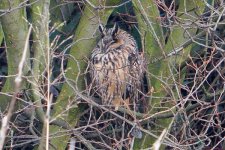SteveClifton
Well-known member
An interesting thread, and I think there will always be fans of both P&S cameras and DSLRs for digiscoping. In the end it really isn't so clear cut as some are stating, and there seems to be a general consensus amongst many posters on this thread that:
1. Digiscoping with a digital compact is slow/difficult to focus
2. Images are noisy at high ISOs
3. Digiscoping set-ups are heavy and unweildly to carry around.
I have been using a Fuji f30, and latterly F31 with a Swarovski scope and DCA adapter for the past 2-3 years, and maintain that all of the above statements are untrue.
1. So long as the scope is approximately focussed on the subject, the F31 snaps easily and quickly into focus most of the time. Most of the time I find digiscoping quick and easy, even fun! (otherwise I probably wouldn't bother!) though I realize that this is subjective and dependent on experience, but then so is successful bird photography with any set-up.
2. This is true with many P&S cameras, but with my Fuji I can get noise free images at ISO800, which are at least as good as my Olympus E510 DSLR can do at ISO400 (probably closer to it at ISO100 or 200). However, I am aware that many Canon/Nikon DSLRs easily beat my Olympus for high ISO performance.
3. For ease of carrying, and discounting the weight of the tripod which would be needed even for long lens work with a DSLR, my set-up is around 1.7KG, including the camera and adapter. How many Astro scopes, long lens DSLR combos can beat this for reach/price/weigh/durability/waterproofing etc.
I am not trying to compete with other posters on this issue, or state that anyone else is wrong. I have seen some of the results from Paul Corfield, Neil and several other 'experts' in their respective fields, and to be honest all of these methods are capable of producing fantastic results. To be honest, I think the individual's personal style of birding/photography is more important than what the specific kit is capable of producing when considering what to buy, as are issues of price too.
I would like to experiment more with my DSLR, and ultimately think it is capable of great results given a cooperative subject, but for ease of use, speed and ease of carrying I don't think digiscoping can be beaten for most birders who want to take good pictures of birds while out birding (given the right combination of camera/scope/adapter).
If however, you want the absolute best quality images; you don't mind lugging the extra weight or setting up in one spot and waiting; and you are prepared to go for an astro scope over a more rugged/compact spotting scope, then probably the DSLR route will serve you better. Just different strokes for different folks...
Steve
1. Digiscoping with a digital compact is slow/difficult to focus
2. Images are noisy at high ISOs
3. Digiscoping set-ups are heavy and unweildly to carry around.
I have been using a Fuji f30, and latterly F31 with a Swarovski scope and DCA adapter for the past 2-3 years, and maintain that all of the above statements are untrue.
1. So long as the scope is approximately focussed on the subject, the F31 snaps easily and quickly into focus most of the time. Most of the time I find digiscoping quick and easy, even fun! (otherwise I probably wouldn't bother!) though I realize that this is subjective and dependent on experience, but then so is successful bird photography with any set-up.
2. This is true with many P&S cameras, but with my Fuji I can get noise free images at ISO800, which are at least as good as my Olympus E510 DSLR can do at ISO400 (probably closer to it at ISO100 or 200). However, I am aware that many Canon/Nikon DSLRs easily beat my Olympus for high ISO performance.
3. For ease of carrying, and discounting the weight of the tripod which would be needed even for long lens work with a DSLR, my set-up is around 1.7KG, including the camera and adapter. How many Astro scopes, long lens DSLR combos can beat this for reach/price/weigh/durability/waterproofing etc.
I am not trying to compete with other posters on this issue, or state that anyone else is wrong. I have seen some of the results from Paul Corfield, Neil and several other 'experts' in their respective fields, and to be honest all of these methods are capable of producing fantastic results. To be honest, I think the individual's personal style of birding/photography is more important than what the specific kit is capable of producing when considering what to buy, as are issues of price too.
I would like to experiment more with my DSLR, and ultimately think it is capable of great results given a cooperative subject, but for ease of use, speed and ease of carrying I don't think digiscoping can be beaten for most birders who want to take good pictures of birds while out birding (given the right combination of camera/scope/adapter).
If however, you want the absolute best quality images; you don't mind lugging the extra weight or setting up in one spot and waiting; and you are prepared to go for an astro scope over a more rugged/compact spotting scope, then probably the DSLR route will serve you better. Just different strokes for different folks...
Steve
Last edited:




